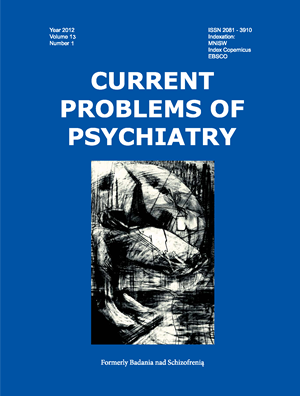Multiscale entropy analysis of EEG signals
Keywords:
multiscale entropy, EEG, complexity, diagnosisAbstract
The paper presents a novel way to analyze biological signals using an signal processing technique, called multiscale entropy and its applications in psychiatry. As an entropy-based algorithm, it measures degree of complexity of a given signal. The multiscale feature enables to assess the performance of the human brain over the various frequency bands of the electroencephalography (EEG) signal. The complexity of the EEG signal may reflect the ability of the system to react to the changes in the surrounding environment and thus be a marker of disease.
In this paper, the classical definition of entropy and multiscale entropy (MSE) is presented. Then three examples of the application of the MSE in psychiatry are shown, namely changes of the MSE curve with age, as well as in Alzheimer's disease and for early diagnosis of autism in infants.
References
1. Takahashi T. Cho R. Y. , Murata T., Mizuno T., Kikuchi M., Mizukami K., Kosaka H., Takahashi K., Wada Y. Age-related variation in EEG complexity to photic stimulation: A multiscale entropy analysis. Clinical Neurophysiology 120 (2009) 476-483.
2. Costa M., Goldberger A.L., Peng C.-K. Multiscale entropy analysis of biological signals. Phisical Review, 2005.
3. Richman J. S., Moorman J. R. Physiological time-series analysis using approximate entropy and sample entropy. Am J Physiol Heart Circ Physiol. 278: H2039-H2049, 2000.
4. Costa M., Goldberger A. L., Peng C. K., Multiscale Entropy Analysis of Complex Physiologic Time Series. Physical Review Letters. (89) 2002.
5. Goldberger A.L.,Penga C.K., Lipsitz L.A. What is physiologic complexity and how does it change with aging and disease? Neurobiology of Aging 23 (2002).
6. Mizuno T., Takahashi T., Cho R. Y., Kikuchi M., Murata T., Takahashi K., Wada Y. Assessment of EEG dynamical complexity in Alzheimer’s disease using multiscale entropy. Clinical Neurophysiology 121 (2010).
7. Bosl W., Tierney A., Tager-Flusberg H., Nelson C. EEG complexity as a biomarker for autism spectrum disorder risk. BMC Medicine 2011 9:18.
8. Xie HB, He WX, Liu H: Measuring time series regularity using nonlinear similarity-based sample entropy. Phys Lett A 2008, 372.


